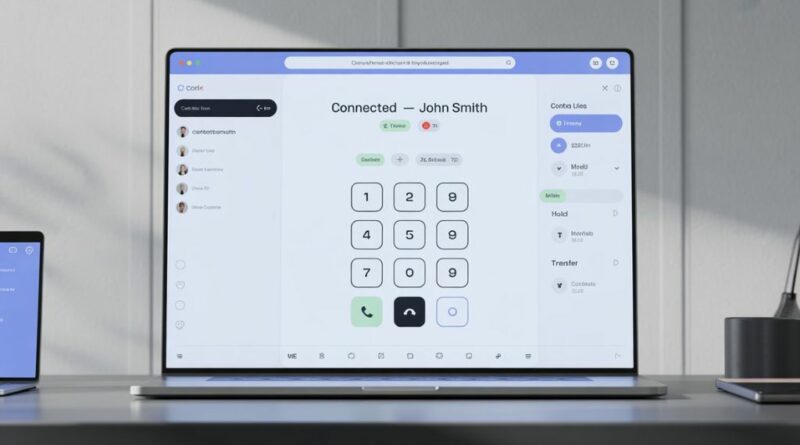Browser SIP Client (WebRTC Softphone) for PBX
Modern teams live in the browser. Installing and maintaining desktop softphones slows everyone down. A WebRTC softphone (browser SIP client) puts secure, crystal-clear calling into any modern browser—no downloads, no VPN, no IT tickets. Below you’ll see how it works, why it’s different from UCaaS “phone apps,” how it connects to Asterisk/FreePBX or cloud PBX, and how to roll it out in minutes.
Quick start: try the product on the browser SIP client page.
What Is a WebRTC Softphone?
A WebRTC softphone is a SIP client that runs entirely in the browser. It uses WebRTC for media (audio/video) and encryption, and speaks SIP to your PBX or SBC—often via a lightweight SIP↔WebRTC proxy.
Key benefits
- Zero installs: open a tab, log in, start calling—ideal for remote agents and hot-desking. See the full list on features.
- Secure by default: SRTP/TLS with STUN/TURN for NAT traversal; details on security.
- PBX-friendly: works with Asterisk, FreePBX, FusionPBX, Kamailio, OpenSIPS, and most SIP trunks; see integrations for Asterisk and integrations for FreePBX.
- Scale fast: onboard a new agent in under 5 minutes—follow getting started.
How a Browser SIP Client Connects to Your PBX
- User signs in to the web softphone.
- The client registers to your PBX via TLS using SIP over WebSockets (WSS).
- Calls negotiate media with WebRTC (ICE + STUN/TURN) and stream with DTLS-SRTP.
- Optional: a SIP↔WebRTC proxy normalizes codecs, handles ICE candidates, and simplifies firewalling—diagram in how it works.
Result: encrypted signaling + media, reliable setup behind NAT, excellent call quality—without installing anything.
Features Teams Actually Use
- Click-to-call & call pop from CRM/helpdesk pages (see CRM shortcuts)
- Call controls: transfer (blind/attended), hold, mute, DTMF, recording (see call control)
- Presence & BLF so transfers land first time
- Multi-device login alongside desk phones or mobiles
- Policy & audit: enforce TLS/SRTP; log call events for QA/compliance (security & compliance)
- Asterisk/FreePBX integration: reuse extensions, dialplans, and queues—setup guides for Asterisk and FreePBX
WebRTC Softphone vs. Traditional Softphone or UCaaS App
- Installs: WebRTC runs in the browser; apps require downloads/updates.
- Security: WebRTC ships with DTLS-SRTP/TLS; legacy RTP can be unencrypted (see security overview).
- Control: keep your own PBX and routing; avoid vendor lock-in.
- Time to value: first call within minutes—start on webrtc softphone setup.
Who Benefits Most
- Contact centers & support desks needing rapid onboarding
- Hybrid/remote teams on Chromebook/Mac/Windows/Linux
- PBX owners wanting modern browser calling without replacing their stack
- Compliance-minded orgs needing encryption and auditability
Setup Checklist (≈10 Minutes)
PBX readiness
- Enable SIP over TLS
- Codecs: Opus, G.711
- NAT helpers (Asterisk:
icesupport=yes,directmedia=no) — see Asterisk notes
Edge / proxy (recommended)
- Deploy SIP↔WebRTC proxy (WSS + ICE/TURN)
- Open ports for WSS and TURN (often TCP/UDP 443) — more in network requirements
Users
- Create or reuse SIP extensions
- Provide credentials (username, domain, TLS) — user onboarding
Go live
- User opens browser, signs in, allows mic, places test call
- Verify transfers/recording policies, then roll out to team via deployment checklist
Security & Call Quality (What IT Cares About)
- Encryption: TLS for signaling + DTLS-SRTP for media
- NAT traversal: built-in ICE/STUN/TURN for home/guest networks
- QoS tips: prefer Opus, prioritize UDP 443, keep TURN close to agents—see quality guide
Pricing & Deployment Options
- Free tier / pilot: validate call flows with a small team—pick pricing to compare tiers.
- Business: SSO, call recording, audit logs, SLA support
- Enterprise: HA TURN pools, custom SBC rules, and compliance features
You keep numbers, trunks, dialplans, and recording strategy. The browser softphone is a thin client that upgrades your existing PBX—see why keep your PBX.
Example Use Cases
- Sales & SDR: dial from CRM, auto-log, coaching recordings (see sales workflows)
- Support: warm transfers, presence-aware routing, in-browser QA review (see support workflows)
- Field ops: calling on lightweight laptops—no corporate image needed
FAQs
Is it compatible with Asterisk/FreePBX?
Yes—registers as a SIP endpoint over WSS/TLS. You can reuse dialplans, queues, and trunks.
Do I need a TURN server?
For remote users and strict NATs, yes. TURN guarantees media when peer-to-peer paths fail—see TURN/STUN guide.
Does it support call recording and transfers?
Yes—attended/blind transfer, hold, DTMF, and recording (subject to PBX policies). See call controls.
Can I use desk phones and the browser together?
Yes—multi-registration lets a desk phone and the web softphone run in parallel on the same extension.
What about video calling?
Video is native to WebRTC. Enable it per policy; audio-only can remain default for call-center use. Planning a rollout? Read adding video to your PBX.
Call to Action
Ready to try the browser SIP client? Start free today and place your first secure WebRTC call in minutes—no installs required.
- Primary CTA: Start Free
- Secondary CTA: Talk to an engineer
For more articles like this visit www.softpagecms.com



